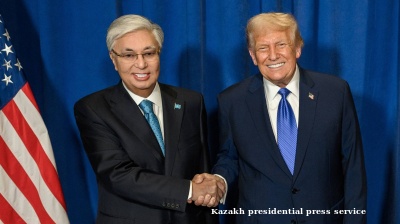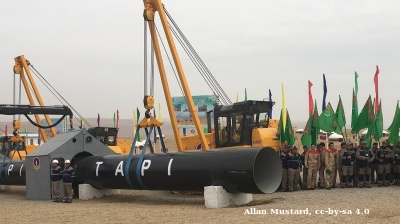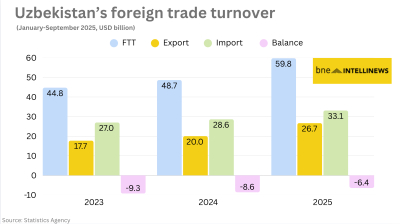Tajikistan, Central Asia's poorest nation, is in danger of defaulting on its first ever Eurobond as the construction of the giant Rogun hydropower dam gobbles up scarce resources.
Most of the proceeds of the $500mn Eurobond issued in September 2017 have been invested in the enormous dam, but as that cash runs out the state is still spending a quarter of its entire budget on the construction. Investors are getting the butterflies, worried that the government won’t be able to service its debt. The World Bank was against the project from the start, but with two turbines already operational it doesn't seem like the government is going to give up on the full scope of the ambitious project.
Conceived in Soviet times, the construction of Rogun is a potential game-changer for the country. Building work resumed a few years ago and the first turbines went into operation in November 2018. But the dam is far from finished and if it is completed not only will it solve all Tajikistan’s power problems, it could earn the economy significant revenue from power exports to neighbours, including Pakistan and Afghanistan.
The problem is that the dam is huge - it was originally designed to be the tallest in the world at 335 metres but it is not clear the present design aims for quite so high. However, it is so big that the World Bank says the country simply can’t afford to build it and has refused to fund it. But that hasn't stopped President Emomali Rahmon from going ahead.
“There is no other country in the region in which tradable sovereign debt would be exclusively a funding vehicle for just one piece of infrastructure. We believe that the scale of the Rogun HPP project is, in the context of Tajikistan, so significant that it dwarfs the importance of ‘traditional’ macro and sovereign credit metrics,” Petr Grishin, an economist at VTB Capital (VTBC), wrote in a report on Rogun.
As a dam, Rogun has many advantages. It would help improve Tajikistan’s electricity balance, including in winter; it would alleviate the regional shortage of ‘hot reserve’ that can meet fluctuations in demand quickly; it would stabilise river flows by creating the first multi-year regulation reservoir; it would postpone sedimentation and improve the firm generation capacity of Nurek and other downstream hydro power plants (HPPs).
From a market point of view the dam has a lot of problems. It won’t make enough money from the domestic market to pay the Eurobond off, as Tajikistan has the lowest power tariffs in all Central Asia and there is only one industrial customer in the country that demands a lot of power – the Talco aluminium plant. The other countries of Central Asia also don't pay much for power, but the Afghan and Pakistan markets would pay more, if the power from the dam can be hooked into their power grids.
Despite all the problems the president is determined to build the dam come what may, although he admits it is already “underfunded.”

Power cuts leave Tajikistan in the dark
Tajikistan is suffering from a chronic shortage of energy and the winter blackouts affect seven out of 10 Tajiks each year. The sporadic supplies of gas mean residents abandoning their kitchens and building wood- or dung-fired traditional kazan ovens in the playgrounds of residential blocks as well as ripping out radiators from their apartments and selling them for scrap metal, as there is never any hot water in them in the winter.
Tajikistan used to produce a small amount of gas in Soviet days. It peaked at around 500mn cubic metres a year in 1990, against the 2bn cubic metres it consumed then, mostly supplied by Uzbekistan. But today Uzbekistan is itself short of gas and any surplus is sold to China. Uzbekistan stopped deliveries to Tajikistan completely in 2012, although there was a resumption of tiny amounts to industrial clients in April as relations improved. Tajikistan’s own gas production has completely collapsed to a mere 4 mcm per year.
The only energy Tajikistan produces domestically is hydropower, but the main river these stations rely on is the Vakhsh (which means “wild”). It flows 30 times faster in the summer, as the snow in the mountains melts, than it does in the frozen winters. The upshot is that about 70% of the population suffer from acute power shortages every winter.
Rogun would solve these problems by creating a reservoir so large that it would not only smooth out the supply of power over the year, it would also produce a reserve of water that can even out the flows over several years.
The first studies on the dam were conducted in 1967. Construction was finally begun in 1976 and continued until 1993, when a flood destroyed the dam, after which the project was abandoned. However, by that time 21km of tunnels had been completed, the underground halls for turbines had been 70% finished, the transformer hall was 80% ready and two turbines had been built. They are currently producing power.
The dam was destroyed in 1993 because the tunnels that were supposed to relieve the pressure were not finished. Rock and debris filled the overflow tunnels, which collapsed and caused the water in the reservoir to build up and flow over the top of the damn, sweeping it away. According to flooding studies made since, the chances of this happening again, now the tunnels have been properly lined, is equivalent to a once-in-10,000-years event.
Default or refinancing on the cards?
The government has spent all the money raised from its Eurobond issue on the dam. What worries the international financial institutions (IFIs) and investors is that Rogun is consuming so much of the state’s resources that the latter will be unable to meet its obligations and will default on its first ever international bond.
“The SCD finds that under the status quo approach, the pursuit of the continued borrowing for the Rogun HPP could risk debt sustainability and threaten the country’s economic and social stability,” the World Bank wrote in the Systematic Country Diagnostics report of May 2018.
The government’s external debt burden is not that high at 51.4% of GDP, but it has released little information for the benefit of bondholders. At the last count at the end of the first quarter of this year the government said total external debt was $2.7bn.
Even when completed the Tajik domestic power business will never generate enough money to pay off the Eurobond. The prices of power in Tajikistan are just too low. And efforts to improve payment discipline have often backfired, with inspectors reading meters often generating more fraud than they uncover, the domestic power operator reports. Tajikistan will have to export power to earn enough money.
BT, the integrated national energy company, is loss-making and deeply in debt. The residential tariff is Tajik soum (TJS) 0.23/kWh and Talco, the largest consumer of power in the country, pays even less (TJS0.072 in summer and TJS0.118 in winter). These are the lowest tariffs in the region and owing to the widespread poverty in the country there is little room to increase the tariffs.
Currently Tajikistan doesn't earn much from exports and lives almost entirely on remittances sent home by workers in other countries – mostly Russia – to cover its negative trade balance. This source of hard currency is also where the money will come from to cover the bond payments.
All the rubles sent back to Tajikistan from Russia, which accounts for 80% of the transfers by value, are mandatorily converted to Tajik soum on arrival; however, dollars and euros do not have to be converted. The national bank uses the rubles to buy dollars on the open market in Moscow and so build up some hard currency reserves. According to the Central Bank of Russia (CBR), Tajiks sent a total of $2.5bn back home in the 12 months up to the end of September.
This limited supply of foreign currency means the national bank has to “ration” the supply of FX to banks to meet domestic demand for dollars, leading to regular shortages, according to VTBC.
“We say ‘rations’, because the exchange rate, as everywhere in the region, remains controlled by the [National Bank of Tajikistan]. This precludes the FX rate from finding an equilibrium level at which the market would clear automatically, giving rise to periodic bouts of complaints, easily traceable in media, about ‘shortages’ of foreign currency. It might be a pure coincidence, but in 2019 such outbursts have come before coupon payments on the bonds: in February and then in late summer/early autumn,” Grishin said.
The demand for remittance-secured FX by local businesses to pay for things like imports means that only 3% of the $2.5bn per year of inflows is available for debt servicing, according to VTBC.
Now all the bond money has gone, the government has been forced to turn to the budget to pay for more work and Rogun is gobbling up an unprecedented amount of public funds.
“Under the ‘development of the fuel and energy sector’, spending on RHPP for 2019 has been approved at TJS4.1bn. This is 23% of all expected revenues (including grants), or 80% of VAT – the largest single revenue item. It is also almost as much as total public spending on education (TJS4.4bn) or, for example, 2.5x the total public sector wage bill. To stress the point again, this is outright incomparable to any other country we cover,” says Grishin.
And the projection for 2020 is for TJS3.5bn, rising again to TJS5bn and TJS6.2bn in the next two years after that.
Now the first units of Rogun are online, Tajikistan can make some money from power exports. Exports of power have increased 10-fold in the last three years but they still only earned $28mn in the second quarter of this year. Nevertheless, the total of $80mn the government anticipates earning this year is an important contribution to servicing the debt.
| Electricity flows, million kWh | ||||||||||
| Export | 192.7 | 459.4 | 627.4 | 133.4 | 101.6 | 1,181.00 | 1,577.00 | 129.3 | 269.2 | 1,093.70 |
| Import | 18.8 | 29.2 | 34.7 | 27 | 0.2 | 6 | 3.8 | 0.3 | 43.4 | 85.5 |
| Net export | 173.9 | 430.2 | 592.7 | 106.4 | 101.4 | 1,175.00 | 1,573.20 | 129 | 225.8 | 1,008.20 |
| Foreign trade value, $mn | ||||||||||
| Export | 8.1 | 17.4 | 23.3 | 4.7 | 3.7 | 26.1 | 42.6 | 3.5 | 10.2 | 29.8 |
| Import | 0.2 | 0.3 | 0.3 | 0.3 | 0.2 | 6 | 3.8 | 0.3 | 0.4 | 1.4 |
| Net export | 7.9 | 17.1 | 23 | 4.4 | 3.4 | 20.1 | 38.8 | 3.2 | 9.8 | 28.4 |
| Source: Tajstat, VTB Capital Research | ||||||||||
Another source of cash is gold mining. Both Moody’s and S&P have pointed to the country’s significant gold deposits as a potential source of income.
However, the country’s reserves are currently “very low”, according to Moody’s. Excluding gold and SDRs, the national bank’s latest reserves number in July was $355mn – and that represented a rise from a recent nadir of $275mn set in May, the lowest level since the Eurobond was placed back in 2017. It seems the government just sold four tonnes of gold to boost its reserves.
Tajikistan produces enough gold to be able to sell between $150mn and $200mn a year without running down the gold it holds in its reserves, according to VTBC estimates.
Add to this the $80mn from electricity exports the country is expecting to earn this year and the 3% of remittances the government can dedicate to debt servicing and the state has resources of around $355mn a year at most to spend on a debt repayment bill of $247mn due this year.
“But that doesn't leave any room for mistakes or shocks,” says Grishin.
| Tajik debt repayment schedule and sources, $mn | |||||
| 2019 | 2020 | 2021 | 2022 | 2023 | |
| Pre-eurobond: Principal | 134 | 136 | 186 | 194 | 212 |
| Pre-eurobond: Interest | 77 | 81 | 82 | 84 | 85 |
| Eurobond: Interest | 36 | 36 | 36 | 36 | 36 |
| Total interest | 113 | 117 | 118 | 120 | 121 |
| Total debt service | 247 | 253 | 304 | 314 | 333 |
| Earmarked sources | |||||
| Gold monetization (@1,000/oz) | 200 | 150 | 150 | 150 | 150 |
| Net electricity exports | 80 | 88 | 97 | 106 | 117 |
| Remittances ('working capital' effect) | 75 | 75 | 75 | 75 | 75 |
| Total estimated sources | 355 | 313 | 322 | 331 | 342 |
| Source: Company data, VTB Capital Research | |||||
Earthquakes and regional power politics
The Pamir mountains are not stable and are prone to earthquakes, but the Soviet engineers got round that by building a constriction that is essentially a shell filled with sand that corrects and fills up any gaps created in an earthquake.
This solution was used to build the Nurek hydro-plant downstream of Rogun, constructed during the time of the Soviet Union in 1961-1978. It has worked very well. These dams are known as impervious core embankment dams. Correctly layering rock and other materials not only makes the stability of the structure less susceptible to displacements caused by seismic activity, it also makes the pores that can be created by seismic events as a result of the movement of the structure self-filling. As the name suggests, only the core must be impervious, being made of clay. The rest of the dam consists of rock of various types, all drawn from local sources.
In half a century of operation, Nurek has not suffered a single seismic event that would jeopardise the dam or indicate a threat to the stability of its structure. There are additional complications at Rogun – such as the presence of geological faults and a salt wedge right at the foundation of the dam – that call for additional solutions, according to VTBC.
Beyond the ability to control the river flows throughout the year more rationally, greater control of the amount of water also has important regional political implications.
After the collapse of the Soviet Union, the “hydrocarbon” countries of the region decided to charge higher prices for the winter energy they produced from fossil fuels, pointing to global price levels. That led the “hydro” countries, such as Tajikistan, to shift and rely more on their water resources in their energy regimes. But as they discharged more water in the winter, to avoid expensive imports, they were quickly embroiled in rows with counties such as Uzbekistan, the cotton crop of which, worth billions of dollars a year in exports, is affected by the lack of water in the summer.
“It took years for the countries to regain at least some ability to co-operate in this exchange, trading summer water for winter energy,” says Grishin.
Rogun means that Tajikistan will have a vast reserve of water that it can tap and use in energy negotiations with its neighbours, improving its position politically in the region.

Exports remains key
Exports of excess power generated by Rogun are the key to the whole puzzle and have already begun. the cash-strapped government has already diverted power from the domestic market to exports, causing power shortages at home earlier this year.
Power exports over the first half of this year were 1,257mn kWh, up by exactly a third year on year. Exports accounted for about a tenth of the 10.1bn kWh that Tajik generated during this period. That was only up 6.6% y/y, so the government was sacrificing domestic supply to make a little extra money. All in all, Tajikistan has signed off on deals to export 3.2bn kWh this year, which is a third more than last year.
And exports will continue to rise. Since the two turbines came online at Rogun, Tajikistan has already surpassed its Soviet era record generation production of 18.6bn kWh set in 1988. That was with the 19.7bn kWh it produced in 2018.
Uzbekistan is a major customer and demand from the Uzbeks is highest in the second half of the year, rising from around 110-120mn kWh per month in April to circa 400mn kWh in the autumn.
Although the price Tashkent pays in the low season rises from only $0.02/kWh to $0.025.kWh in the high season, which is little different to the domestic tariffs, Uzbekistan pays in dollars whereas the domestic market earns the government local currency, so the government is keen to export to bolster its hard currency reserves.
The Afghan export channel is less well developed and has suffered setbacks. One of the towers on the export transmission line to Kunduz was blown up at the end of 2018, reportedly by the Taliban, but it was restored in May 2019. And in October there were reports of another attack on a tower. The instability in Afghanistan makes it an uncertain transit route to the bigger and richer market in Pakistan. Still, the Afghan exports are more lucrative for Tajikistan, as the prices are twice as high as those in Uzbekistan at $0.04/kWh, minus the transit fees Dushanbe has to pay Tashkent.
It took some time to build a bypass around Turkmenistan from Tajikistan via Uzbekistan to Afghanistan. The Turkmen are not co-operating in the development of a regional grid. In general, the advent of the new Uzbek administration under President Shavkat Mirziyoyev has led to a rapid improvement in relations between Tashkent and Dushanbe that is being manifested in new joint infrastructure projects.
However, the project still has its work cut out. The construction of the dam needs to be completed and more turbines installed. There has been a lot of investment into the Central Asian Power System (CAPS) but more 500-kWh loops need to be built so countries can better share their excess production. And a power delivery system traversing Uzbekistan and Afghanistan to Pakistan needs to be built. All this will take years to complete and it’s still not clear where the money will come from.
Features

Washington has a new focus on a Caspian energy play
For most of the last three decades since winning independence, Central Asia has been a bit of a backwater. Not any more. The Trump administration is becoming more focused on Turkmenistan's vast gas reserves and can smell money and power there.

BOTAŞ and Turkey’s hub ambition: from “30-year dream” to cross-border reality
For Ankara, the symbolism is as important as the molecules: Turkey’s energy map is shifting from end-market to hub.

Indian bank deposits to grow steadily in FY26 amid liquidity boost
Deposit growth at Indian banks is projected to remain adequate in FY2025-26, supported by an improved liquidity environment and regulatory measures that are expected to sustain credit expansion of 11–12%




